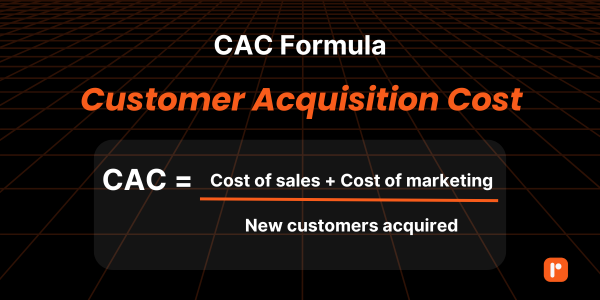What’s the Real Cost of Getting a Customer? (CAC)
CAC isn’t just a number—it’s a key to understanding how well your business is running.
What It Really Takes to Acquire a Customer
Imagine you run an eCommerce store that sells sustainable fashion.
You’ve poured your heart into curating eco-friendly clothing, launched a beautifully designed website, and started running ads to attract customers.
But there's a burning question that nags at you: How much does it really cost to bring in each new customer?
This is where Customer Acquisition Cost (CAC) comes into play—a critical metric that can make or break your eCommerce business.
Understanding CAC is more than just calculating a number.
It’s about unlocking insights into the efficiency of your marketing, refining your strategy, and ultimately driving sustainable growth.
Let's break it down👇.
Customer Acquisition Cost (CAC)
At its core, CAC tells you how much you’re spending to bring one new customer through your digital doors.
It's calculated by dividing the total amount spent on marketing and sales by the number of new customers acquired in a specific period.
CAC = Total Marketing and Sales Spend / Number of New Customers Acquired
Now, why does this number matter so much in eCommerce?
Because every dollar you spend needs to result in a customer that will not just buy once but hopefully buy multiple times, boosting your long-term profitability.
But CAC isn’t just about spending; it’s a window into the health of your business strategy.
Let’s dive into a real-world scenario to make this crystal clear.?
The Facebook Ads Dilemma: A Real-World Example
Imagine you’re the owner of EcoThreads, an eCommerce brand selling eco-friendly clothing.
You decide to run Facebook ads to attract new customers, spending $10,000 over one month.
By the end of the campaign, you’ve acquired 200 new customers.
Using the CAC formula:
CAC=10,000 / 200=50
Your CAC is $50, which means you spent $50 to acquire each customer.
But what does this number tell you?
On the surface, $50 might seem reasonable, especially if your average order value is high enough. But to truly assess whether this is sustainable, you need to zoom out and consider the bigger picture.
What Influences CAC in eCommerce?
Several factors affect your CAC, and understanding these can help you optimize your strategy:
Marketing Channel
Different marketing platforms will have varying costs. Facebook ads might bring in a lot of traffic, but Google Ads might be more cost-effective, depending on your target audience.
If your CAC is too high, it could be a sign that you're investing in the wrong channels.
Customer Journey
How many touchpoints does it take for a visitor to convert into a customer? A long, complex funnel with multiple retargeting ads, emails, and social media touchpoints can drive up your costs.
Simplifying the journey can lower CAC.
Brand Awareness
If your brand is well-known, customers might be more willing to purchase without extensive persuasion.
This reduces your marketing spend and, in turn, your CAC. Startups and lesser-known brands will often have a higher CAC as they need to establish trust and familiarity first.
Product Price Point
High-ticket items can tolerate a higher CAC because of the larger profit margins. Conversely, if you're selling low-cost items, even a small increase in CAC can hurt profitability.
If this is the first time you discovered Retainful, take your time, and keep consuming this newsletter & you will eventually increase your store’s revenue.
Turning CAC from a Cost into an Investment
Many eCommerce business owners see CAC purely as a cost, something to reduce as much as possible. But savvy entrepreneurs view it as an investment.
Let me explain why.
When you calculate your CAC, it shouldn’t exist in isolation. You should always compare it to your Customer Lifetime Value (CLTV).
CLTV represents the total amount of money a customer will spend on your store over their entire relationship with your brand.
If your CLTV is significantly higher than your CAC, you have a profitable business.
For example, let's say your CAC is $50, and the average customer spends $100 per order and makes 4 orders over 2 years.
This gives you an LTV of $400. Now, spending $50 to acquire a customer who will generate $400 in revenue over time suddenly looks like a brilliant investment.
The key is balancing the two metrics. If your CAC is approaching or exceeding your CLTV, it's time to reassess your strategy.
On the other hand, if your CAC is much lower than your CLTV, you might want to consider increasing your marketing spend to grow faster—because you're making a good return on each customer acquisition.
How to Reduce CAC Without Compromising on Quality
While CAC is a critical metric, reducing it without losing quality is the ultimate goal. Here are a few ways to lower CAC and increase your profitability:
Refine Targeting
Ads that reach the right audience are more effective and less costly.
Use customer personas, A/B testing, and data-driven insights to ensure your ads are targeting those most likely to convert.
Improve Retention
Acquiring new customers is expensive.
Focusing on customer retention strategies, such as loyalty programs and personalized marketing, can help maximize the revenue you get from each acquisition, indirectly lowering CAC over time.
Leverage Organic Channels
Building a strong social media presence, improving SEO, and focusing on content marketing are excellent ways to attract traffic without paid ads.
While this might take longer, the long-term payoff can dramatically reduce your CAC.
Optimize the Sales Funnel
If visitors drop off at certain stages of the buying process, your marketing spend is wasted.
Simplify the checkout process, reduce distractions, and improve the overall user experience to convert more visitors into buyers.
New to Retainful?
Simply put - Retainful is an email marketing automation tool for ecommerce businesses, helping 16,000+ businesses across 120+ countries recover $600M in revenue.







